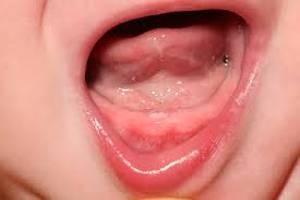 Most babies start teething around about 6 months, but don’t worry if your baby grows their teeth much earlier or later than this. Some babies will even be born with teeth (although this is very unusual and shouldn’t interfere with breast feeding).
Most babies start teething around about 6 months, but don’t worry if your baby grows their teeth much earlier or later than this. Some babies will even be born with teeth (although this is very unusual and shouldn’t interfere with breast feeding).
The first teeth to come through are the bottom middle incisor teeth. The top front teeth (incisors) come through between 6-8 months. This is followed by the top & bottom second incisors between 9-12 months.
The first set of back molars then appear between 12-16 months, leaving a space for the eye teeth (canines) to erupt at 16-20 months. The last ones to come through are the second set of back molar teeth which appear around the age of 2-2.5 years.
As you can see, the poor wee souls (and their parents!) don’t get much of a break between teeth coming through and we’ve found that the worst ones for causing pain seem to be the first incisors and back molars. So you could say that teething starts and ends with a bang!
Teething symptoms
 If you’re lucky, your babies teeth will grow through with no pain or discomfort at all. Usually though, you will notice that the gum looks sore, red, swollen and inflammed. One, or both of their cheeks might look a bit flushed and you will probably find they will dribble more. They will want to chew on anything and everything they can get their hands on, and you may even hear them grinding their teeth together. Your baby will probably be more grumpy and clingy than usual, and a baby who was once a good sleeper can start wakening up again multiple times through the night.
If you’re lucky, your babies teeth will grow through with no pain or discomfort at all. Usually though, you will notice that the gum looks sore, red, swollen and inflammed. One, or both of their cheeks might look a bit flushed and you will probably find they will dribble more. They will want to chew on anything and everything they can get their hands on, and you may even hear them grinding their teeth together. Your baby will probably be more grumpy and clingy than usual, and a baby who was once a good sleeper can start wakening up again multiple times through the night.
Some people think that a fever, a runny nose or diarrhoea can be linked to teething but there’s no evidence that this is the case. But you will know your baby best and if you feel worried that your babies symptoms are severe or unusual then do come and see us or seek medical advice.
Tips for helping a teething baby
 There are several ways you can try and help a teething baby. Not everything will work for every child, so you may have to try a few different things until you find something that works for yours.
There are several ways you can try and help a teething baby. Not everything will work for every child, so you may have to try a few different things until you find something that works for yours.
Teething Rings
Teething rings give your baby something to safely chew on, which may ease their discomfort and provide a distraction from any pain. You can cool the teething rings in the fridge to help soothe your baby’s gums. A useful alternative to a teething ring is a cold, wet flannel.
Never put a teething ring or flannel in the freezer as it could damage your baby’s gums if it becomes very hard or cold. Also, never tie a teething ring around your baby’s neck, as it may be a choking hazard.
Cool Food & Drinks
 Cool, sugar-free drinks will help to soothe your baby’s gums and may help if they are dribbling excessively. The best option is to give them cool water in a free flow sippy cup.
Cool, sugar-free drinks will help to soothe your baby’s gums and may help if they are dribbling excessively. The best option is to give them cool water in a free flow sippy cup.
You can also give your baby healthy snacks to chew, such as raw fruit and vegetables. Pieces of apple and carrot, served cool from the fridge are often ideal. You could also try giving your baby a crust of bread or a breadstick. Always stay close in case they choke.
It is best to avoid rusks because nearly all brands contain some sugar. Avoid any items that contain lots of sugar as this can cause tooth decay even if your child only has a few teeth.
Painkilling Medicine
 If your baby is in pain or has a raised temperature, you may want to give them a painkilling medicine that has been specifically designed for children. These medicines contain a small dose of paracetamol or ibuprofen to ease any discomfort and will often help your baby to sleep better. Always choose a sugar free and follow the dosage instructions that come with the medicine. If you are not sure, ask your GP or pharmacist.
If your baby is in pain or has a raised temperature, you may want to give them a painkilling medicine that has been specifically designed for children. These medicines contain a small dose of paracetamol or ibuprofen to ease any discomfort and will often help your baby to sleep better. Always choose a sugar free and follow the dosage instructions that come with the medicine. If you are not sure, ask your GP or pharmacist.
Sugar Free Teething Gels
For babies over four months old, you can rub sugar-free teething gel on their gums. You can get teething gel from your local pharmacy.
Teething gels often contain a mild local anaesthetic, which helps to numb any pain or discomfort caused by teething. The gels may also contain antiseptic ingredients, which help to prevent infection in any sore or broken skin in your baby’s mouth.
Make sure you use a teething gel specifically designed for young children and not a general oral pain relief gel, which is not suitable for children. It is important to make sure the teething gel does not contain salicylic salts. Your pharmacist can advise you about this.
Comforting a teething baby
 Comforting a teething baby with lots of cuddles can often distract them from the pain in their gums. Your baby may be feeling too irritable or restless to play, but at other times, it may be a good way of getting them to concentrate on something other than their teething pain.
Comforting a teething baby with lots of cuddles can often distract them from the pain in their gums. Your baby may be feeling too irritable or restless to play, but at other times, it may be a good way of getting them to concentrate on something other than their teething pain.
If teething is making your baby dribble more than usual, make sure you frequently wipe their chin and the rest of their face. This will help to prevent them from developing a rash. You may also find it useful for your baby to wear a bandana bib and sleep on an absorbent sheet.
And most importantly, as soon as your babies first teeth appear, you need to brush them twice a day with a fluoride toothpaste! If you would like any further information or advice, please do not hesitate to contact us, and remember, we like to see you and your child at the practice from birth upwards.
Opening Hours







Reviews







